Introducing SEO: Your quick-start guide to effective SEO practices
by Aravind Shenoy and Anirudh Prabhu
The Making of the Oxford English Dictionary
by Peter Gilliver
The Language of Technical Communication
by Ray Gallon
Making Sense: A Student’s Guide to Research and Writing – Engineering and the Technical Sciences, 5th ed.
by Margot Northey and Judi Jewinski
Teach Students How to Learn: Strategies You Can Incorporate Into Any Course to Improve Student Metacognition, Study Skills, and Motivation
by Saundra Yancy McGuire with Stephanie McGuire
Wordplay: Arranged and Deranged Wit
by Howard Richler
True Print
by Dafe Kühne
Teaching and Researching Writing: Applied Linguistics in Action, 2nd ed.
by Ken Hyland
Pre-suasion: A Revolutionary Way to Influence and Persuade
by Robert Cialdini
The Chicago Guide to Grammar, Usage, and Punctuation
by Bryan A. Garner
The Ultimate Freelancer’s Guidebook: Learn How to Land the Best Jobs, Build Your Brand, and Be Your Own Boss
by Yuwanda Black
Chaos Monkeys: Obscene Fortune and Random Failure in Silicon Valley
by Antonio García Martínez
Everything Explained That Is Explainable: On the Creation of the Encyclopædia Britannica’s Celebrated Eleventh Edition, 1910-1911
by Denis Boyles
The User’s Journey: Storymapping Products That People Love
by Donna Lichaw
Michael Allen’s Guide to e-Learning: Building Interactive, Fun, and Effective Learning Programs for Any Company, 2nd ed.
by Michael W. Allen
Draplin Design Co.: Pretty Much Everything
by Aaron James Draplin
The Blended Course Design Workbook: A Practical Guide
by Kathryn E. Linder
The New Web Typography: Create a Visual Hierarchy with Responsive Web Design
by Stephen Boss and Jason Cranford Teague
The Origins of Ethical Failures: Lessons for Leaders
by Dennis Gentilin
Written English: A Guide for Electrical and Electronic Students and Engineers
by Steve Hart
But Can I Start a Sentence with “But”? Advice from the Chicago Style Q&A
by The University of Chicago Press Editorial Staff
The Other Kind of Funnies: Comics in Technical Communication
by Han Yu
Book Cover Designs
by Matthew Goodman
How to Write and Publish a Scientific Paper, 8th ed.
by Barbara Gastel and Robert A. Day
Virtual Teams in Higher Education: A Handbook for Students and Teachers
by Madelyn Flammia, Yvonne Cleary, and Darina M. Slattery
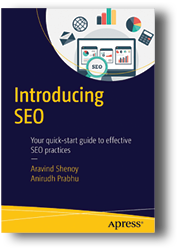
Introducing SEO: Your quick-start guide to effective SEO practices
Aravind Shenoy and Anirudh Prabhu. 2016. New York, NY: Apress. [ISBN 978-1-4842-1853-2. 134 pages, including index. USD$29.99 (softcover).]
Search Engine Optimization (SEO), according to Shenoy and Prabhu, provides ways to “improve the visibility of websites using different strategies and techniques” (back cover) and that is the working definition for SEO as it is used in Introducing SEO: Your quick-start guide to effective SEO practices.
This book’s audience could be writers, marketers, or others who support SEO efforts or those who want an introduction to the topic with the idea of becoming the technical support for SEO efforts. The authors have a good grasp of the subject and pick an interesting, informative array of topics for Introducing SEOs. Shenoy is a technical writer by trade, coming from Mumbai, India, and being an author of several other books. Prabhu is a user interface (UI) Developer specializing in HTML, CSS, and JavaScript, with this being his second book.
Effective use of keywords, link building, and online social media marketing appear in part as what this book covers. These techniques contribute to having a site appear appropriately in search engine results.
Readers of Introducing SEO will appreciate the many examples and screenshots that appear as with tools such as Google Analytics (pp. 44-48) providing information on numbers and locations of visitors and trends.
Sitemaps appear as a chapter where the authors explain this as a “list of pages within a website” which can “exist in a form accessible to crawlers, humans, or both” (p. 63). The two versions of sitemaps are XML and HTML. The HTML version is human friendly while the XML version is “tailored for the search engines” with sitemaps telling “search engines about the content type on the listed pages” (p. 63). Readers should find the example XML and HTML sitemaps in this book of interest.
You do not need any prior knowledge of SEO before reading Introducing SEO – Your quick-start guide to effective SEO practices as it is meant for a novice audience.
Jeanette Evans
Jeanette Evans is an STC Associate Fellow and active in the NEO community, currently serving on the newsletter committee. She holds an MS in technical communication management from Mercer University and published titles such as “Emerging Technologies: Where We Have Been and Where We Are Going” and “What We Can Learn from Project Managers” in STC’s Intercom magazine.
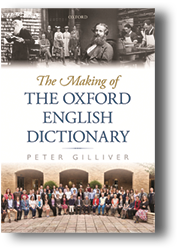
The Making of the Oxford English Dictionary
Peter Gilliver. 2016. New York, NY: Oxford University Press. [ISBN 978-0-19-928362-0. 626 pages, including index. US$65.00.]
In 1857, members of the London Philological Society had for some time been dissatisfied with the available dictionaries, so they established a committee to determine lists of words that were not found. The Unregistered Words Committee consisted of three members: Herbert Coleridge, the grandson of Samuel Taylor Coleridge; Richard Trench, the Dean of Westminster; and Frederick Furnivall.
Peter Gilliver, in his The Making of the Oxford English Dictionary, divides this scholarly book into 13 chapters with an interesting “Interlude” where he explains how the editors used quotations found by readers. He traces the origin of the Oxford English Dictionary (OED) to a paper by Trench, a theoretical, historical philosophy to be used when constructing a new dictionary.
The first editor of the OED was Coleridge (appointed 1858). Unfortunately, he had tuberculosis and died on April 23, 1861. Furnivall became the next editor. The most famous early editor of the OED was James Murray (appointed in 1876).Once the Society decided to create a new dictionary, they needed to find a publisher. Eventually, after being turned down by a number of publishers because of the size of this project, Oxford University Press (OUP) agreed to take it on.
To try to make the work systematic, the Society divided the history of language into three periods: from the 1100s to 1526; 1526 to 1674, the death of Milton; and 1674 to the present. Further, the Society established two committees: one looked at words and meanings and the second looked at etymologies. The appointed editor would manage both.
The method the Society agreed on was to invite readers to submit quotations they found while reading that used the words. Eventually, Murray had to build a separate building behind his house calling it the Scriptorium to house not only the growing staff but also the slips, which, by the 21st century, totaled well over 10 million.
While the book is clearly aimed at a scholarly audience, technical communicators can find material relating to managing large projects. Gilliver covers, for example, the costs to OUP, eventually running into millions of pounds as the project continued with vague prospects of recovering all or part of that expenditure. A second area was time; how much time could be devoted to developing this dictionary, which translates into increased costs and personnel needs. Third, Murray and future editors were constantly arguing with OUP about quality, again related to time and costs.
The Making of the Oxford English Dictionary contains an astounding number of footnotes. In, for example, Chapter 3, there are almost 300 footnotes. OUP can broaden the book’s appeal by separating source from content footnotes. Besides this problem, Gilliver has written an interesting book on how this dictionary went from proposals in 1858 to its current form, which is the OEDonline (also called OED3). So if you have an interest in how meaning develops, The Making of the Oxford English Dictionary is a good book for you to have personally or in the company library.
Tom Warren
Tom Warren is an STC Fellow, Jay R. Gould Award for Excellence recipient, and professor emeritus of English (technical writing) at Oklahoma State University, where he established the BA, MA, and PhD technical writing programs. Past president of INTECOM, he served as guest professor at the University of Paderborn, Germany.
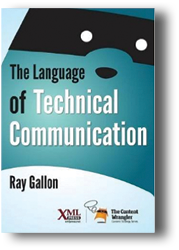
The Language of Technical Communication
Ray Gallon. 2016. Laguna, CA: XML Press. [ISBN 978-1-937434-48-9. 136 pages, including index. US$24.95 (softcover).]
Gallon’s The Language of Technical Communication is really a kind of glossary that focuses on content. He identifies 52 terms that are central to technical communication and then asks knowledgeable people what the terms mean and why they are important. Gallon adds a brief biography and contact information for each responder and follows up with an answer to his own question: “Why does a technical communicator need to know this?” Most of the explanations are one or two sentences with some (John Carroll’s comment on “minimalism,” for example) not even being a sentence.
Gallon divides the terms into 5 groups: Core Concepts (Part I); Technical Concepts (II); Standards and Conventions (III); Deliverable Presentations (IV); and Future Directions (V). The division allows random access to specific terms without having to read cover-to-cover. Besides Subject and Contributor Indexes, he provides a list of other terms focusing on content strategies based on Ann Rockley’s Managing Enterprise Content.
The listing suggests several questions: for example, Why these 52 terms? Why 52 and not more or fewer? Why these “experts”? All would be easily answered in the “Preface” but aren’t. Yet, if Gallon has in mind the assumed reader mentioned by Alan Houser in the Foreword, his assumed readers range from technical communicator trainees needing an introduction to their new jobs to experienced communicators who want to keep current. The questions can be important.
The more natural reader should be students being introduced for the first time to technical communication as a discipline. When studying any discipline, students must first master the discipline’s terminology before moving on to the specifics. Several other disciplines have such vocabularies. For example, in rhetoric, there is A Handlist of Rhetorical Terms that provides a vocabulary for students studying rhetoric.
Two suggestions for a second edition: (1) a brief “For Further Reading” section and (2) where appropriate, an example. A reader who may have heard of metadata may want to read more about it. Also, cross-referencing: Why, for example, isn’t the entry on “Omnichannel” (p. 74) cross-referenced to “Single Sourcing” (p. 56) and vice versa? Cross-referencing the term to more general terms such as DITA and XML would be a start, but a reference to a basic metadata primer would be more helpful. Some readers would not know, even from “Why is it Important” and “Why does a technical communicator need to know this” just what metadata looks like. So a brief example would help. Second as I mentioned above, I think the book would be better targeted to students rather than practitioners, although they would also benefit from having the terms available. Not only would the student market be larger, and perhaps lead to a reduced price, but also the students would learn what the vocabulary is for their chosen discipline.
Tom Warren
Tom Warren is an STC Fellow, Jay R. Gould Award for Excellence recipient, and professor emeritus of English (technical writing) at Oklahoma State University, where he established the BA, MA, and PhD technical writing programs. Past president of INTECOM, he served as guest professor at the University of Paderborn, Germany.
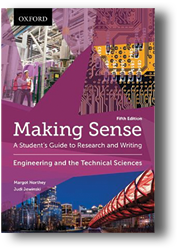
Making Sense: A Student’s Guide to Research and Writing – Engineering and the Technical Sciences
Margot Northey and Judi Jewinski. 2016. 5th edition. New York, NY: Oxford University Press. [ISBN 978-0-19-901025-7. 274 pages, including index. US24.99 (softcover).]
Margo Northey and Judi Jewinski’s 5th edition of Making Sense: A Student’s Guide to Research and Writing – Engineering and the Technical Sciences combines the essentials of technical writing with the utility of a handbook. Clearly written, direct, concise, and yet comprehensive in covering the fundamentals, the book takes an unadorned, business-like approach, like a Strunk & White version of technical writing.
As such, this book is ideal for instructors looking for a framework they can supplement with their own examples and specific content. The book is organized to follow “a standard developmental process from design to prototype to product” (p. vii) that lets the instructor reflect on the reality of documenting product development through the course curriculum. Instructors can then customize the basic material—such as generic descriptions of IMRAD (Introduction, Method, Results, and Discussion) and the format of proposals and project reports—to fit the make-up of a particular class.
An unusual addition for a technical writing text is a chapter on “writing in other contexts” that offers advice on generic pre-writing principles, organizing argumentative essays, preparing for and writing essay tests, and writing reviews of books or articles. Also unusual is the section on laboratory notebooks, especially the emphasis on the need for rigorous documentation and the legal consequences of careless record keeping. Both of these additions are valuable, original, and definitely useful for undergraduate students.
Similarly useful is the crisp, practical advice on organizing and documenting collaborative efforts. Students tend to think of group work as informal, when of all technical endeavors, it probably requires the most professionalism. Successful teamwork requires a formal, disciplined approach: assigning and documenting roles and responsibilities, recording individuals’ progress in fulfilling their obligations, tracking progress with meeting minutes, recording technical and scientific progress in a lab notebook, generating and using a Gantt chart to manage the schedule, and providing templates for each team member to document work completed. Such rigor may surprise students, but is utterly consistent with professional engineering and scientific work.
The chapter on presentations emphasizes the need to map the content to the audience’s level of knowledge and to answer the “So what?” question by explaining why anyone other than the presenter should care about the project. Similarly, resumes and cover letters are not autobiographies but marketing tools designed to show how the applicant’s skills and experience can help a company solve its problems. In each case, the student learns that fulfilling the audience’s needs is paramount to successful communication.
As noted, Making Sense also functions as a handbook, with clear advice on usage, punctuation, grammar, and techniques for helping English as a Second Language (ESL) students. The glossary and comprehensive index make using the text as a reference easy. For instructors who prefer to supplement a text with their own material, this book is ideal.
Donald R. Riccomini
Donald R. Riccomini is an STC member and a senior lecturer in English at Santa Clara University, where he specializes in teaching engineering and technical communications. He previously spent twenty-three years in high technology as a technical writer, engineer, and manager in semiconductors, instrumentation, and server development.
Teach Students How to Learn: Strategies You Can Incorporate Into Any Course to Improve Student Metacognition, Study Skills, and Motivation
Saundra Yancy McGuire with Stephanie McGuire. 2015. Sterling, VA: Stylus Publishing. [ISBN 978-1-62036-316-4. 240 pages, including index. US$32.00 (softcover).]
During your university odyssey, you might have failed to notice that the ability to learn isn’t innate; it’s a skill that must be taught to students, but rarely is. As a result, most students enter university unaware they must become active problem-solvers rather than passive receivers of information. Academics know this implicitly, but like most subject-matter experts, forget that students don’t share their knowledge. Challenging teachers to reject their assumption that students arrive at university prepared to learn—and convincing them to teach their students new ways of learning—is the goal of Teach Students How to Learn: Strategies You Can Incorporate Into Any Course to Improve Student Metacognition, Study Skills, and Motivation.
In this book, the McGuires emphasize the need to help students rethink their approach to learning by teaching them metacognition skills. They present a structured plan for transforming the learning experience by teaching students Bloom’s hierarchy, effective study and learning strategies, and how to become motivated to learn. These skills are supported by detailed strategies for transferring this knowledge to students. But the authors also remind us that teachers must learn what works from their students; teaching is a partnership, and different partners have different requirements. The book comprehensively summarizes best practices for creating skilled learners who recognize the amount of work required to learn complex subjects and are motivated to do the work. The individual points may seem obvious, but I’ll bet you’re not using them all to guide your teaching. (Mea culpa.) Teach Students How to Learn’s an essential resource because so much information is gathered concisely in one place, with a structured teaching plan that includes downloadable slide sets you can customize for your own students.
The authors cite much anecdata to support their approach, but also a few more rigorous studies that offer convincing evidence. Overall, this may not satisfy the academic mind, but the McGuires persuaded me their approach has enormous potential. Unfortunately, the writing style is an obstacle. The book begins like a late-night infomercial (complete with testimonials), then evolves into a wandering and informal approach that takes several chapters to settle into a more conventional presentation of the authors’ thesis. Once this happens, the book becomes an effective learning tool for teachers, but the organization needs improvement; information that should be integrated with specific chapters often ends up scattered or separated into appendices.
Despite these drawbacks, Teach Students How to Learn provides method and motivation to become more effectively involved in helping your students succeed.
Geoff Hart
Geoff Hart (www.geoff-hart.com) is an editor, technical writer, and translator who often teaches these skills to others.
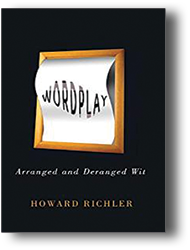
Wordplay: Arranged and Deranged Wit
Howard Richler. 2016. Vancouver, BC, Canada: Ronsdale Press. [ISBN 978-1-55380-452-9. 160 pages, including index. US$19.95 (softcover).]
Wordplay: Arranged and Deranged Wit is written for people who love language, have a sense of humor, and who delight in witticisms crafted by a master wordsmith. It also serves as an introduction to different literary devices that rely on both the intellect of the writer and the reader. Whether you are studying Shakespeare, writing your first novel, or just looking for some enjoyable reading, Wordplay could be the book for you.
Richler begins the book by dividing it into two sections. The first is for “arranged” wit, or literary humor that the author intended. Examples in this section include puns, riddles, and creative insults. The second section is the “deranged” wit, which is more accidental. That section has chapters covering typos, bloopers, malaprops, and mistranslations. Within each section are chapters devoted to a singular theme. For example, one chapter is dedicated to puns. A brief history of puns is included, along with a topology of puns. Examples are given, ranging from Shakespeare to Groucho Marx. The book includes clever quizzes at the end of most chapters that are designed as a puzzle for the reader to test their understanding of the chapter concept. Richler provided some answers earlier in the chapter, but often the puzzles rely on the reader’s thinking skills. To help you keep your wits, instead of losing them, Richler supplies the answers at the end of the book. The second section is structured the same way as the first, but with unintentional verbal humor. The chapter on mistranslations serves as a warning beacon for all people who write for an international audience as to what can and will go wrong in the hands of a poor translator.
Overall, Wordplay is a fun book guaranteed to raise a smile. Readers must be vigilant while perusing the book, since many of the examples require focus to completely appreciate. Not all chapters are as strong as the others, but they are all amusing. The addition of the quizzes in most chapters adds a fun, gaming aspect to the book. So if you like to keep your allegories on the banks of the Nile, know that ancient Egyptians travel by Camelot, regularly read the Gnu’s News (a tabloid for antelopes), or enjoy written humor in general (or out of a general, because in a general it is too dark to read), you’ll appreciate Wordplay.
Timothy Esposito
Timothy Esposito is an STC Associate Fellow with over 15 years of technical communication experience. He is currently president of the STC Philadelphia Metro Chapter. Before becoming president, Timothy was chapter vice president, treasurer, webmaster, and scholarship manager.
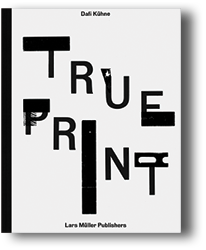
True Print
Dafe Kühne. 2016. Zurich, Switzerland: Lars Müller Publishers. [ISBN 978-3-03778-509-6. 152 pages. US$49.00.]
True Print is a fascinating cultural and historical examination of letterpress printing through the contemporary graphic designer’s lens. The book provides insight and inspiration for everyone who is interested or concerned with typography and graphic communications. This must-have book unveils Kühne’s unorthodox style through an amalgamation of analog and digital tools for letterpress printed posters and labor-intensive typographic compositions for modern visual communication forms.
Kühne is one of the premiere Swiss letterpress printmakers in the 21st century. This book is an all-inclusive record of his innovative design process and abounding body of graphic design work. Contributor Rudolf Barmettler notes, “Dafi always aims to avoid his design looking in any way “retro” or “handmade.” He staunchly opposes romanticized, conventional ideas about wood type and centered composition, and also refuses to idealize nineteenth- and early twentieth-century print technologies. Instead, he seeks out new potential for digital and analog design, as well as possible new approaches to and materials for the letterpress process, beyond the familiar metal type, wood type, and linoleum” (p. 6).
Letterpress typographic design has seen a recent resurgence in contemporary practice. In an era of accelerated technological changes, a small number of graphic designers are reshaping typography from an earlier period for modern visual communication. Hendrik Werman, a Dutch designer and printmaker during the 1920s–1940s, established a benchmark for innovative printing techniques and revolutionary typographic experiments on the printing press. He believed that a more organic, human connection to design was critically important and that graphic design not be confined to the technology of our time. Kühne, in a similar way, applies his handcrafted production to ready-made components and traditional methods, while experimenting with new techniques, unorthodox materials, and different approaches to letterpress printing.
Contributor David Shields points out, “The work is firmly grounded in two approaches: that of the pragmatic commercial printer and that of the experimental designer. The pragmatics of the printer is dependent on the economic need to produce work for a client as quickly and efficiently as possible. The experimental approach grapples with the meaning of the form and works at challenging the visual elasticity of the compositional space…By combining these seemingly antithetical approaches, Dafi uniquely carves out a hybrid space for both experiment and production” (p. 12).
From beginning to end, Kühne has laid out a beautiful design system that flows in a free, harmonious manner revealing lettering styles and constructing a rare jewel of typographic art. True Print is an all-important handbook for design students interested in letterpress printing as well as an indispensable guide for professional designers, or anyone interested in letterpress revival and both traditional and recent Swiss graphic design history.
Richard Doubleday
Richard B. Doubleday is an associate professor in Graphic Design at Louisiana State University’s School of Art. He is a contributing author of Dialectic, a scholarly visual communication journal, and Graphic: 500 Design that Matter. Richard has been published extensively in leading graphic design journals.
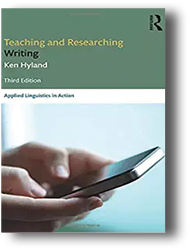
Teaching and Researching Writing: Applied Linguistics in Action
Ken Hyland. 2016. 2nd ed. New York, NY: Routledge. [ISBN 978-1-138-85946-3. 316 pages, including index. US$51.95 (softcover).]
Teaching and Researching Writing: Applied Linguistics in Action is an extraordinary example of thoroughly researched, yet readable scholarly writing that is understandable to students and useful to veteran teachers and academics who study writing.
The third edition is a complete reorganization of the second edition and includes new chapters and information about current writing technology, research regarding technology and writing, automated marking, and the dominance of English in the globalized world. As Hyland mentions, “the broad scope of what we know about writing and how we might best teach it remains, but the field has also changed” (p. xi). This new edition goes to great lengths to include information about these changes in teaching and researching writing. To grasp the breadth and depth of these changes, Hyland takes readers on a progressive journey through the orderly organization of four sections. “Understanding Writing” provides an overview of the main approaches to writing, key understandings of writing and writing research, and debates and topics for further exploration. This section lays out many foundational theories of writing and writing research that prepare readers for “Researching Writing.” Included in this section are chapters on research design, research topics, and two chapters that explore research case studies, their design, aims, results, discussion, and opportunities for future research. The chapters in “Teaching Writing” demonstrate the importance and practical application of theory in the classroom. The theoretical foundations explored in the chapter “Approaches to Teaching Writing” are useful for novice and experienced teachers who learn or revisit theories associated with the various ways writing can be taught in the classroom, such as text-, writer-, and reader-oriented approaches. As an experienced writing teacher, I found myself analyzing my own approaches to teaching writing and visualizing ways I can incorporate other perspectives. Especially helpful is the chapter “Teaching Writing: Classes and Courses,” which provides course syllabi, methods, materials, and assessments for several classes where readers can borrow in whole or part whatever works best for their own classes. The “References and Resources” section includes up-to-date books, articles, Web sites, listservs, and other resources that any student, teacher, or researcher will find helpful in their own endeavors. It is a storehouse of contemporary resources.
Each chapter has visual guides to help readers comprehend key points, which is helpful with such a comprehensive book. Such guides include a bulleted list of what each chapter covers and textboxes that bullet or number key concepts and quotes from reputable writers, researchers, and teachers. The textboxes are not simply visual aids; they provide context and background information for theoretical discussions within the chapters. Hyland mentioned teachers, practitioners, and researchers as his main readers; however, Teaching and Researching Writing is so well organized and well written that it would be a good resource for college students to learn about the foundational theories and issues about teaching writing.
Diane Martinez
Diane Martinez is an assistant professor of professional and technical communication at Western Carolina University. She previously worked as a technical writer in engineering, an online writing instructor, and an online writing center specialist. She has been with STC since 2005.
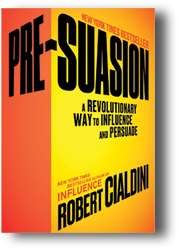
Pre-suasion: A Revolutionary Way to Influence and Persuade
Robert Cialdini. 2016. New York, NY: Simon and Schuster. [ISBN 978-1-5011-0979-9. 414 pages, including index. US$28.00.]
Pre-Suasion: A Revolutionary Way to Influence and Persuade comes over 30 years after Robert Cialdini’s influential book Influence, but the newer work really serves as a prequel. Pre-suasion argues that people can increase their odds for effective persuasion by setting the stage before making their big ask. As Cialdini writes, “the effectiveness of persuasive messages…will be drastically affected by the type of opener experienced immediately in advance” (p. 75). To bolster its provocative central claim, the book’s three parts offer plenty of accessible data and an array of interesting anecdotes and examples.
Part 1 focuses on ways that channeling attention in favorable directions primes people for persuasion later on. According to Cialdini, humans naturally assign extra importance and causality to whatever they are paying attention to. For instance, jurors more often believe false confessions when a camera films a suspect’s face directly rather than an entire interrogation room, and people will more likely choose French wines when French music plays in the background. Aspiring persuaders can deploy relevant cues to direct an audience’s attention, making them more receptive to the eventual message.
Part 2 argues that pre-suaders should create favorable associations. Once we pay attention to something, we’re more likely to notice and act on related ideas. Cialdini argues that “influence attempts, including pre-suasive ones, will be successful only to the extent that the associations they trigger are favorable to change” (p. 16). In one of Cialdini’s examples, the power of association explains why employees at a call center perform better after viewing a photo of a runner winning a race. Pre-Suasion offers several tools, including framing, metaphor, and even place to help pre-suaders create similar productive associations.
Part 3 offers best practices, beginning with six time-tested concepts for directing attention and persuading audiences: reciprocation, liking, social proof, authority, scarcity, and consistency. Cialdini adds a seventh concept, unity, which focuses on the persuasive power of shared identities. Most importantly, Cialdini offers a chapter on the ethics of persuasion that, while short and placed close to the book’s end, encourages readers to consider the consequences of their persuasion attempts. A final chapter discusses post-suasion—strategies for making persuasion stick after the act—but this brief section feels more like a teaser for a third book in a trilogy.
Cialdini breaks new ground by emphasizing how persuasion begins long before it becomes obvious. Communicators, whether they consider themselves overtly persuasive or not, can “up” their game by realizing how many factors contribute to a successful message. Because the book targets a mass audience, some of the concepts and examples obviously hold more direct relevance for technical communicators than others. But anyone with interest in language, persuasion, and human behavior will learn a lot from Pre-suasion.
Ryan Weber
Ryan Weber is an STC member and program chair for the STC Huntsville/North Alabama chapter. He directs the Business and Technical Writing Program at the University of Alabama in Huntsville. Ryan hosts the podcast 10-Minute Tech Comm featuring interviews with technical communication scholars and practitioners.
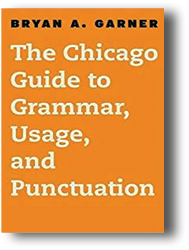
The Chicago Guide to Grammar, Usage, and Punctuation
Bryan A. Garner. 2016. Chicago, IL: The University of Chicago Press. [ISBN 978-0-226-18885-0. 584 pages, including indexes. US$45.00.]
If you have used the 15th or 16th edition of The Chicago Manual of Style (CMS), Garner’s name should be familiar. Beginning in the 15th edition, he contributed a chapter on grammar and usage. Now he has built on that work to produce The Chicago Guide to Grammar, Usage, and Punctuation.
He divides the Guide into five major sections: Grammar (“The Traditional Parts of Speech”), “Syntax” (including sentence diagramming), “Word Formation” (morphology), “Word Usage” (based on his Garner’s Modern English Usage), and “Punctuation.” He adds a “Selected Glossary,” “Bibliography” of quotations, a “Select Bibliography,” two indexes (“Word” and “General”), and a “Pronunciation Guide.”
In the Introduction, Garner briefly traces the history of grammatical study as well as asserting that his object is to provide a practical approach to his topics. Numbering the various subsections as found in CMS makes quick access possible even though the indexes cite page and not section numbers. His approach, although he states that it will be descriptive, quickly becomes rule-based and derives from Standard Written English. Grammar, Garner tells us, is a set of rules governing utterances.
Part I, “The Traditional Parts of Speech,” looks at the eight traditional parts of speech. After a brief introduction, he mentions other numbers ranging from 4 to 10 and even as many in America grammar as 33. He settles on eight because from 1761, in British English, eight was widely accepted because Joseph Priestley was its main advocate. Garner also supplies the linguistic vocabulary for many of the traditional terms.
Part II, “Syntax,” discusses types of sentences and clauses and includes sentence diagramming and transformational grammar. In Part III, “Word Formation,” he divides words into prefixes, stems or base words, and suffixes.
Part IV, “Usage,” has a short introductory note and then a lengthy (95 pages) listing of troublesome usages. An interesting feature is that Garner uses Google ngrams, graphs showing occurrences of usage based on Google’s corpora of about every book published between 1500 and 2008. He also includes a section on bias-free language. His comments on usage could also serve as the book’s purpose: “What is intended here is a guide that steers writers and editors toward the unimpeachable uses of language…” (p. 224).
Finally, Part V covers the usual “Punctuation” marks.
The back matter includes a number of sections. Besides the many extended definitions found throughout, Garner includes an 88-page Select Glossary as well as two bibliographies, two indexes, and a pronunciation guide.
Garner’s The Chicago Guide to Grammar, Usage, and Punctuation will have several uses for technical communicators. The most obvious use would be for those who edit text. Other uses would include as a reference when composing and evaluating texts. A grammar companion such as this one to CMS and an authoritative dictionary would establish language authority across company texts. Therefore, this work is highly recommended.
Tom Warren
Tom Warren is an STC Fellow, Jay R. Gould Award for Excellence recipient, and professor emeritus of English (technical writing) at Oklahoma State University, where he established the BA, MA, and PhD technical writing programs. Past president of INTECOM, he served as guest professor at the University of Paderborn, Germany.
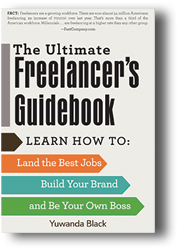
The Ultimate Freelancer’s Guidebook: Learn How to Land the Best Jobs, Build Your Brand, and Be Your Own Boss
Yuwanda Black. 2016. Avon, MA: Adams Publishing. [ISBN 978-1-4405-9678-0. 272 pages, including index. US$16.99 (softcover).]
Black had in mind an audience of young freelancers when she wrote The Ultimate Freelancer’s Guidebook: Learn How to Land the Best Jobs, Build Your Brand, and Be Your Own Boss. Her audience should get valuable information as the book adequately covers the freelancer audience.
Practical issues such as pros and cons of incorporation, legal advice, traditional business plans, retirement, and budgets are some of the topics, as are freelance success stories. How to land your first clients and build a brand are topics Black covers in some depth as you would expect for the audience. She also notes that freelancing is now a big market and growing.
With a home base in Kingston, Jamaica, Black has been featured in publications such as the Chicago Tribune, Savoy Professional, and Wall Street Journal’s RealEstateJournal.com. Her site at http://inkwelleditorial.com gives readers tips on writing and where to find work. She owns Inkwell Editorial – an online information portal for editorial professionals and a site for information on the business of freelance writing.
The Ultimate Freelancer’s Guidebook tackles a subject somewhat outside of the traditional technical writing domain, covering more a freelancer perspective. I saw, for example, a remarkably negative review of this book and its author, yet others gave the book a top review. I suppose I could think this is all in a day’s work for a freelancer. Emotions can run high and the public can see an airing of grievances in the public domain.
Jeanette Evans
Jeanette Evans holds an MS in technical communication management from Mercer University and published in Intercom articles including “What We Can Learn from Project Managers” and a column on emerging technologies in education. She achieved the rank of Associate Fellow and participates in the NEO STC community, currently serving on the newsletter committee and last presenting at an NEO STC meeting on the topic of emerging technologies
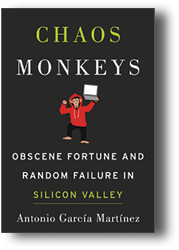
Chaos Monkeys: Obscene Fortune and Random Failure in Silicon Valley
Antonio García Martínez. 2016. New York, NY: HarperCollins. [ISBN 978-0-06-245819-3. 516 pages, including index. US$29.99.]
Imagine monkeys running through a computer center flicking switches and pulling out plugs at random, and in general causing as much chaos as possible. Software developers run the software equivalent of chaos monkeys to test their code and find the weaknesses in their systems.
In this insightful and witty book, Martínez suggests that internet entrepreneurs—with their drive to innovate and disrupt—are society’s chaos monkeys, breaking things at random, bringing benefits, but also threatening whole industries, and the jobs that go with them: think Amazon and bookstores; Uber and taxicabs; Airbnb and hotels and a city’s rental stock. With more candor than many industry insiders, Martínez permits himself to wonder whether society can survive the disruption.
But considering broad social implications is to get ahead of the story. The main thrust of Chaos Monkeys: Obscene Fortune and Random Failure in Silicon Valley is to show that living by the doctrine “move fast and break things” (p. 257) makes life an unpredictable, high-risk game for the monkeys too.
Based on notes and archived emails, Martínez attempts to paint as accurate a picture as possible of what he experienced during the years (2007–2014) he spent living in the economy’s fast lanes.
Briefly, Martínez dropped out of a PhD in physics to work as a strategist for Goldman Sachs. He soon left for Silicon Valley, worked for one startup, then founded another and shepherded it to acquisition. Joining Facebook, he lived through an IPO, and as product manager, developed a real-time ads exchange, all while also trying to balance relationships and have a life. (I don’t want to spoil a fantastic story, so if you want the details, read the book.)
An excellent writer with a wicked wit, Martínez shares his observations and adventures, some of them funny—brewing beer at Facebook and accidently flooding CEO Mark Zuckerberg’s desk—others insightful and instructive. Martínez is a keen observer who has seen and understood much. Where needed, he provides clear explanations of any technical, legal, or procedural matters—the complexities of incubating a startup, the rituals involved in securing venture capital—needed to understand the story. He offers informed, often scathing, opinions on such things as the “indentured servitude” of the H-1B visa program, and the financial and social dynamics of stock-based compensation and IPOs, as well as explaining the economics of leveraging user data, advertising-financed “free” services, the workings of ad buying auctions, and much more. Martínez is also free with his opinions of the high-tech corporate environment, and of the menagerie of out-sized egos and personalities that make up Silicon Valley culture.
If you need to better understand the often secretive workings of a segment of the economy that—for better or worse—is remaking our world, or just want to vicariously enjoy the high-octane experience of going along for the ride, Chaos Monkeys is an engrossing read.
Patrick Lufkin
Patrick Lufkin is an STC Fellow with experience in computer documentation, newsletter production, and public relations. He reads widely in science, history, and current affairs, as well as on writing and editing. He chairs the Gordon Scholarship for technical communication and co-chairs the Northern California technical communication competition.
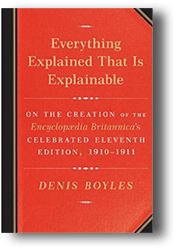
Everything Explained That Is Explainable: On the Creation of the Encyclopædia Britannica’s Celebrated Eleventh Edition, 1910-1911
Denis Boyles. 2016. New York, NY: Alfred A. Knopf. [ISBN 978-0-307-26917-1. 444 pages, including indexes. US$30.00.]
Why should technical communicators want to read about a 1910–1911 encyclopedia? One reason is that when you compare the 11th edition of the Encyclopædia Britannica with the 9th, you see a dramatic change in assumed reader. Also, the staff worked with large amounts of text and authors (over 40,000 entries written by over 1,500 men and 200 women), not to mention production problems—all technical communication concerns.
Denis Boyle’s discussion in Everything Explained That Is Explainable: On the Creation of the Encyclopædia Britannica’s Celebrated Eleventh Edition, 1910–1911 falls into three parts. The first, pre-11th, discusses the 9th and 10th editions. The second examines the 11th itself. The third covers post-11th.
The pre-11th focuses on what to do with left over copies of the 9th. The major problem was that the volumes were issued as completed, so that when they published the last volume (1860) it was almost 20 years out of date. The answer was to issue supplemental volumes that quickly turned into the 10th edition.
This part also discusses a new field, advertising. How do you sell an out-of-date reference work? The [London] Times agreed to offer it under what was then the radical plan of a down payment and installment payments. For The Times this approach added needed revenue as other publishers bought book advertisements.
Boyles then moves into the mechanics of producing a new encyclopedia. The central issue was whether to publish all volumes at once, or follow the 9th and publish each volume as it was completed. All at once won out. This issue was only one of several confronting the 11th. Lawsuits over partnerships and ownerships, severing the The Times connection, and establishing a relationship with Cambridge University Press occupied the non-editorial staff.
The third covers the reception of the 11th. Early reviews were favorable, but reviews written by subject experts and published in scholarly journals were contentious. To modern sensibilities, the 11th and previous editions offer significant problems. For example, early 20th century opinions of nonwhite races were decidedly racist and based not solely on emotion but also “science.” Scientists, including Darwin, agreed on the inferiority of the non-white races.
Boyles covers much more in detail, and you begin to wonder what is so great about the 11th. One answer is that it was actually published and a second was how the new approach to advertising made it great and worthy of the history. You can also argue that the editorial work of Hugh Chisholm made it special.
We finally get to Boyle’s answer in the “Postscript” where he argues that the 11th is more “plausible, reasonable, unruffled, often reserved, and completely authoritative” (p. 332) than encyclopedias prior to and after the 11th. Further, “those with a taste for the wry can easily read it as an experimental fiction about a place that really existed, once” (p. 332). Even with all that, Boyles is an enjoyable read.
Tom Warren
Tom Warren is an STC Fellow, Jay R. Gould Award for Excellence recipient, and professor emeritus of English (technical writing) at Oklahoma State University, where he established the BA, MA, and PhD technical writing programs. Past president of INTECOM, he served as guest professor at the University of Paderborn, Germany.
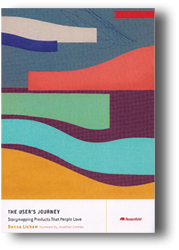
The User’s Journey: Storymapping Products That People Love
Donna Lichaw. 2016. Brooklyn, NY: Rosenfeld Media. [ISBN 978-1-933820-31-6. 146 pages, including index. US$39.00 (softcover).]
We learned early that a good way to prepare a communication is to divide it into parts. First, in elementary school, we struggled to learn about outlining: Divide your subject and then the parts, each level with its own designation—usually “I” and “A,” etc. Once we mastered this process with content, we moved to dividing creating the communication into parts.
Later still, we learned that both content and process can be viewed as an organized approach. Beginning with Aristotle’s definition of a story in his Poetics (Lichaw brings Aristotle and his view of “story” into the discussion), through more modern uses of analyzing communications such as Kenneth Burke’s dramatic pentad and Robert Horn’s Information Mapping, communicators have recognized the value of dividing both process and content into parts. We then discovered that instead of an outline written out, we can create visuals of the different parts. Storyboarding helped us organize and check for completeness.
Donna Lichaw’s The User’s Journey: Storymapping Products That People Love builds on this history to emphasize that each part along the way is best seen as a story that she asserts is “a framework and a lens with which humans comprehend everything” (p. 4).
She presents three kinds of stories: a Concept story that is a fundamental story and structure that you will use to identify and communicate your core concept…, Origin story that details how someone does something for the first time, and Usage story “… the story of someone using your product or service—step by step” (p. 70). She further identifies seven elements to use for creating and analyzing each main story: exposition, inciting incident/problem, rising action, crisis, climax/resolution, falling action, and end.
Each of Lichaw’s story chapters contains not just visuals, but examples applying the principles explained in the chapter. In addition, beginning with Chapter 4, she includes case studies. One of them about a fictitious company called FitCounter, she carries through chapters 3, 4, and 5. This case study is in addition to her other examples.
Chapters 6 to 8, then, explain how to use storymapping. Chapter 6 addresses the source of material that will create the storymapping including both qualitative and quantitative data that you then use to create the main stories. Chapter 7 offers advice on “mapping concepts and flows onto a narrative arc…” (p. 116) that you create when applying the seven elements. Finally, Chapter 8 brings together all the previous techniques and offers advice on making your product or service attractive to users.
Whether or not storymapping is a process suited to your situation depends on how you want to approach creating the communication, both process and content. Perhaps your product or service does not lend itself to this approach, although Lichaw argues that any situation, any product or service can best be seen as a story.
Tom Warren
Tom Warren is an STC Fellow, Jay R. Gould Award for Excellence recipient, and professor emeritus of English (technical writing) at Oklahoma State University, where he established the BA, MA, and PhD technical writing programs. Past president of INTECOM, he served as guest professor at the University of Paderborn, Germany.
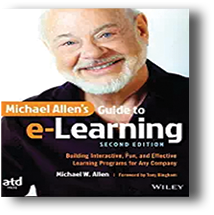
Michael Allen’s Guide to e-Learning: Building Interactive, Fun, and Effective Learning Programs for Any Company
Michael W. Allen. 2016. 2nd ed. Hoboken, NJ. John Wiley & Sons, Ltd. [ISBN 978-11190-4632-5. 432 pages, including index. US$40.00 (soft cover).]
It is obvious why Allen’s text went into a second edition: it models the practices and understanding that the reader develops as they work through the text. The text’s goals, purpose, and applicability are explicit from the start; content is clearly organized, ranging from book sections down to bold headings and well-chunked paragraphs; multiple illustrations support and enhance learning. Equally important, unlike many texts—academic and industry—Michael Allen’s Guide to e-Learning: Building Interactive, Fun, and Effective Learning Programs for Any Company has decently sized type throughout: table of content, titles, headings, and paragraphs. This attention to detail makes reading easier and more pleasurable while supporting old fashioned search and findability.
The index is robust, but the additional resources are a bit lacking given Allen’s history and expertise. Emphasis on the business side of e-learning, as opposed to higher education and will require translation at some points for educators. Most notable, though, for teachers is that many schools do not have the trained staff, resources, and/or e-learning software to make Allen’s examples happen. Nor do we have the time to do all this work, or all the steps, ourselves. Allen’s guide is not a do-it-yourself kit; it assumes that if you are designing content and curriculum that you have healthy or robust resources and other trained personnel with whom to work and obtain support. Reviewing the sections on interactivity, motivation, and serious learning games makes this clear.
For programs, trainers, or faculty teaching instructional design (ID), Allen offers several important points. Most notably, his Successive Approximation Model (SAM). Given how often he references his own model and its importance in the text, they should have put the model earlier than page 297. Emphases on practical, quick, and getting things done prioritize deliverables, all with a stripped-down model. Similarly, if learners have not worked in industry, this text can help students get a different sense of the scope of team work, collaboration, resources, and planning that happen at a larger scale. Allen’s work is a strong complement to any reference library, especially if struggling or caught on a problem. While rhetorical questions in texts are usually irksome, Allen’s use is not only tolerable but effective in most cases.
Several clear audiences for this book: ID newbies; ID courses; ID professionals wanting to improve their professional development. While many ideas herein will be familiar, Allen presents an excellent and reliable net to catch you if you fall off the high wire. Allen’s Guide to e-Learning presents an accessible, friendly, and holistic orientation or reminder of how to engage and motivate learners using multiple techniques, strategies, and approaches. In terms of teaching, learning, usability, and clarity, this is one of the best books on instructional design I have seen in the past five years.
Gregory Zobel
Gregory Zobel is an Assistant Professor of Educational Technology at Western Oregon University.
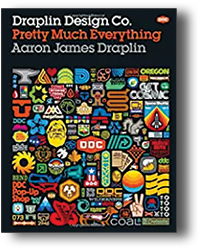
Draplin Design Co.: Pretty Much Everything
Aaron James Draplin. 2016. New York, NY: Harry N. Abrams. [ISBN 978-1-4197-2017-8. 256 pages. US$40.00.]
Draplin is the owner and founder of Draplin Design Co., a nationally known freelance design business, and creator of Field Notes, a popular brand of pocket notebooks. Draplin has gained recognition lately as a public speaker and has been engaged at a range of country-wide events. And now he has authored his first book, Draplin Design Co.: Pretty Much Everything. This book is essentially a collection of design stories and an autobiography of a designer who has made a name for himself despite his humble beginnings.
Draplin is an excellent storyteller, anyone who has seen him talk can attest to this. This holds true in his writing; his approach is entertaining and easy to read. Those who have had the opportunity to see him speak will know that he doesn’t hold back, including his use of profanity, and this book is no exception. However, it did not seem to be overdone or unnecessary, each use emphasizes a point. The book’s tone is unpretentious, easygoing, and unapologetic (yet he apologizes sincerely when necessary) and he even addresses the idea that some say he brings a blue-collar approach to design; in his own words, he unequivocally states that design is a white-collar profession.
The overarching theme for Draplin Design Co. is passion and hard work; Draplin is clearly passionate about being a graphics designer, it shows in the stories he shares about solving design problems and about helping friends through design. This passion is inspiring and his stories exemplify that hard work has been the key to his success. He shares several stories illustrating how hard work and determination have helped him along his path.
The book is also a collection of artifacts and helpful tips besides the stories about his life and designs. The artifacts range from work Draplin did in school and in his early career, examples of his design process, and major projects in his current portfolio, such as Field Notes and designs he did for the government under the United States President Obama. This collection also contains items of design ephemera that he has collected over the years. It is easy to see how these designs, often lost tidbits now found, from design history have informed his design aesthetic. Draplin also provides insight into his process and information that would be beneficial to new designers, such as the “File Handoff Checklist” (p. 242).
Draplin Design Co. is a unique presentation of the designer’s life, education, and business. It will be a great resource for young designers or anyone who is looking for inspiration and a refreshing perspective on the design industry. He includes numerous examples of work, process and inspirational artifacts in along with his text, laid out in a beautiful, yet functional manner. Aaron Draplin has led a life full of experiences, which he shares in his book Draplin Design Co. Pretty Much Everything, design advice that anyone can use.
Amanda Horton
Amanda Horton holds an MFA in Design and currently teaches graduate and undergraduate courses at the University of Central Oklahoma in the areas of design technology, design studio and history of graphic design. She serves as a book reviewer for Technical Communication.
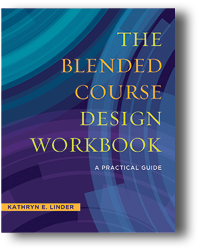
The Blended Course Design Workbook: A Practical Guide
Kathryn E. Linder. 2017. Sterling, VA: Stylus Publishing LLC. [ISBN 978-1-62036-436-9. 224 pages, including index. US$30.00 (softcover).]
The Blended Course Design Workbook: A Practical Guide is a very useful guide for instructors transitioning from traditional to blended delivery. Linder explains how to write course goals and objectives, how to assess students online, and how to design effective learning activities. She also explains how to use technology to support learning, how to access suitable online resources, how to organize blended courses, and how to support online learners. Fortunately, each chapter comprises a similar structure: what do we know about…?; a step-by-step guide to…; key ideas; questions for faculty to ask at their own institution; questions for administrators; and a checklist to document the course design progress.
There are many definitions of blended learning, but the consensus is that a blended environment comprises both face-to-face and online components. Ideally, for a blended environment to be effective, the instructor should purposely align these components, technology should support learning objectives, and active learning methodologies should be employed.
Linder proposes a backward course design approach. In other words, instructors should focus primarily on the intended learning outcomes and then design activities and assessments to enable those outcomes. She cautions against always adopting blended versions of traditional activities and assessments; sometimes alternative options facilitate better outcomes.
In an active learning environment, instructors can use a combination of direct instruction and guided inquiry techniques. Students can engage in different kinds of group work, each with different defining features and learning objectives. Instructors can easily integrate metacognitive activities into blended courses. A flipped classroom, whereby the active learning takes place during face-to-face time, rather than out-of-class, may suit some course topics.
To maximize opportunities for student success, the blended instructor should use a constructive alignment mapping process by aligning course objectives with both face-to-face and online learning activities and assessments. The instructor can share some or all this information with students in a syllabus.
Linder recommends experimenting with only a few tools at a time until students become familiar with them and the instructor can evaluate their effectiveness. She offers recommendations for how best to organize the course content within a learning management system.
The Blended Course Design Workbook offers recommendations on how to prepare students for success. For example, instructors could send a welcome announcement via e-mail, post a welcome video online, and engage with students through a variety of media.
The final chapter in The Blended Course Design Workbook comprises a detailed blended course implementation checklist, which instructors can use to check the alignment of goals, objectives, activities, and assessments.
I find the step-by-step guides, templates, and checklists to be very useful, particularly as they build on one another. In addition, Linder’s references to theories and principles at the start of each chapter give instructors a sound footing on which to design their blended courses. The book’s tone is encouraging, which makes for an easy read.
Darina M. Slattery
Darina M. Slattery has more than 15 years’ experience teaching technical communication and e-learning. She serves as a reviewer for the British Journal of Educational Technology, IEEE Transactions on Professional Communication, Computers and Composition, and Communication Design Quarterly. In 2016, Darina published her co-authored handbook, Virtual Teams in Higher Education: A Handbook for Students and Teachers.
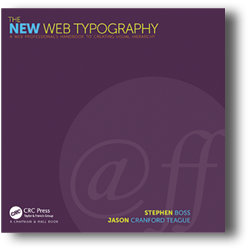
The New Web Typography: Create a Visual Hierarchy with Responsive Web Design
Stephen Boss and Jason Cranford Teague. 2017. Boca Raton, FL: CRC Press. [ISBN 978-1-138-78139-9. 244 pages, including index. US$39.95 (softcover).]
If you’re interested in typography and appreciate a dash of CSS, The New Web Typography: Create a Visual Hierarchy with Responsive Web Design may be the book for you. This book takes a unique approach by comingling topics on typographic design principles and topics on Web font technology. Whereas other books tend to separate the two, the The New Web Typography blends them. This makes this book an ideal resource for students who are new to typography and whose primary medium will be Web sites, mobile apps, and content management systems.
Boss and Cranford Teague offer solid advice for choosing typefaces that goes beyond the usual suggestions of considering x-height; they discuss investigating the font’s repertoire to ensure it contains the characters you need now (and in the future), considering the fonts, weights, and styles, understanding legal issues with fonts, and considering such accessibility issues as dyslexia. The authors outline the advantages and disadvantages of various Web font service bureaus, which should save a new Web typographer valuable time and research.
This is not your average typography book. Typography books usually include the names of typefaces pictured as examples. Sadly, this book didn’t adhere to that convention as I found myself wondering, “What font is that?”
In many ways, The New Web Typography feels like a compilation of old blog posts or presentation notes, hastily repurposed for a book. The underlying principles are still relevant, but the voice is inconsistent and some details are dated.
If we look at the voice, the authors bounce between first-person singular and plural—referring to “I” on one page and “we” on the next. Since the authors don’t distinguish who is writing each paragraph, it’s impossible to know who “I” is.
The volume’s elegant visual tone is undermined by inconsistent typefaces, type sizes, and captioning in the sidebar throughout the book, and stretched and poorly cropped images in chapter 3. Examples of CSS display a variety of spacing and indentations.
Finally, some of the references to technology seem dated. The New Web Typography offers several references to Internet Explorer 6, but no mention of Internet Explorer 10 or 11, or the Microsoft Edge browser. According to Wikipedia, worldwide usage of Internet Explorer 6 fell below 1% in March 2015, so one wonders when the content for this book was written. The references to Adobe Fireworks, which was left behind when Adobe transitioned from CS6 to Creative Cloud in 2013, also seem out of place.
Designing a book that will be picked up by designers and ensuring technology references are up to date is hard work, and Boss and Cranford Teague superbly marry the two topics. However, these examples of inattention to detail are distracting and begin to erode the credibility of a book that otherwise offers excellent advice, is easy to read and navigate, and goes far beyond your traditional books on type.
Michael Opsteegh
Michael Opsteegh is an STC Senior Member and a technical writer in the software and financial services industries since 2004. He is a lecturer in the technical communication program at Cal State Long Beach. Michael holds a master’s degree in English and is a Certified Technical Professional Communicator (CPTC).
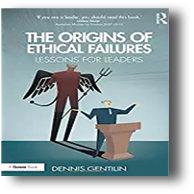
The Origins of Ethical Failures: Lessons for Leaders
Dennis Gentilin. 2016. New York, NY: Routledge. [ISBN 978-1-138-69051-6. 174 pages, including index. US44.95 (softcover).]
Gentilin’s The Origins of Ethical Failures: Lessons for Leaders makes a powerful and necessary contribution to the question of ethical behavior in organizations. Whereas most books on ethics approach the topic from a set of moral norms prescribed by a particular philosophical perspective, using case studies or hypothetical examples to illustrate their argument, Gentilin writes from his personal experience with ethical failure as a trader currency scandal at the National Australia Bank (NAB). He writes both as a theorist and “as a practitioner, in the truest sense of the word” (p. 4).
The academic study of ethics becomes truly meaningful only when its principles are tested in concrete situations with real consequences for the individual. Gentilin’s unrelenting focus on this fact gives his argument an immediacy and credibility very hard to dismiss.
Gentilin’s account is not simply a description of his own experiences, however. Rather, he integrates his personal journey within a framework of psychological theory and experiment characterized by four major influences on ethical behavior in organizations, all present to some degree in every situation. External influences are “contextual,” with the organizational culture the “most significant driver of unethical behavior”; and “relational,” with local peer groups exerting inordinate pressures to conform. Internal influences are “personal,” with our moral compass distorted by the drive for money and power and the fear of failure; and involve “blindness,” our propensity to avoid responsibility by rationalizing our behavior (pp. 7–8). Learning to recognize these factors as they happen helps us recognize and manage challenges to our moral compass.
In each category, Gentilin cites numerous, pivotal studies in psychology in support of his observations, including experiments by Milgram and Zimbardo (obedience), Ariely (monetary incentives), Kahneman (slow and fast thinking), Flood (the Prisoner’s Dilemma); philosophical arguments by Adam Smith (self-interest), Sophocles (know thyself); and historical examples and business cases (the My Lai massacre, the NAB and Pinto scandals). In each case, Gentilin connects his personal experience to the scholarly content and vice-versa, simultaneously universalizing and particularizing the ethical dilemmas he describes, thereby modeling the behavior he recommends.
To his credit, Gentilin refuses to reduce his argument to bumper-sticker platitudes, insisting instead that for individuals only mindfulness—paying conscious attention to how we respond when our moral beliefs are tested—allows us to understand, evaluate, and shape our own behavior. He considers leaders the key to creating ethical organizations, but again only insofar as they act in keeping with the moral behavior they promote.
Gentilin’s argument recalls John Milton’s comment that one “cannot praise a fugitive and cloistered virtue…that never sallies out and sees her adversary.” Like Milton, Gentilin believes cloistered virtue is not virtue, and that ethics matter less when theorized than when tested by reality. Gentilin has written an excellent and timely book—one that should be read and lived by individuals and leaders alike.
Donald R. Riccomini
Donald R. Riccomini is an STC member and a senior lecturer in English at Santa Clara University, where he specializes in teaching engineering and technical communications. He previously spent twenty-three years in high technology as a technical writer, engineer, and manager in semiconductors, instrumentation, and server development.
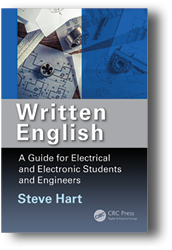
Written English: A Guide for Electrical and Electronic Students and Engineers
Steve Hart. 2016. Boca Raton, FL: CRC Press. [ISBN 978-1-4987-3962-7. 200 pages, including index. US$39.95 (softcover).]
Written English: A Guide for Electrical and Electronic Students and Engineers was a pleasant surprise. Judging from the cover title, I expected yet another dry compilation of guidelines: needful information, but not the most enjoyable experience; far from it. The book comes in a handy size, contains plenty of helpful and real-world examples, and its lively annotations and formatting styles make it excellent reading.
Hart states, “Errors made in papers authorized by writers whose first language is not English are often easily fixed. The issue is one of awareness – and this can be achieved by identifying the mistakes and then providing instruction on how to correct them” (p. xii). The book is definitely successful in doing just this.
Hart provides grammar and background information, but in a condensed, digestible way. What makes this book valuable is the examples. According to Hart, all the examples are “mistakes that have actually been made” (p. xiii).
Written English is divided into two main parts: The first part contains more than 20 sections on key areas of grammar, writing style and formatting. Each section gives basic theory information and lots of practical advice. Hart is not afraid to use different formatting and text elements to the extreme: lists of example errors, Q&A boxes, USE and AVOID tables, “Take care” boxes, common confusions, golden rules, comparing “wrong to right” sentences, arrows pointing from incorrect words in a sentence to the related explanation in a box. This makes the book fun to read and engages you in a pleasant conversation.
The second part is an A-Z list of errors, with terms most commonly misused by writers. The index is perhaps not as comprehensive as you would expect and contains single level entries.
With this mixture of theory, examples and solutions, you can use the book as a general reader from beginning to end or as a reference work. For example, while the “Verbals” section deals among other things with “dangling modifiers”, a challenge familiar to technical writing, the “Equations” section devotes a subsection to the equals sign, which I have so far not given much thought: “In mathematics, the equals sign (=) is considered a verb and is the fundamental part of an equation. Without an equals sign the information cannot be referred to as an equation. It is an expression instead” (p. 134)
Written English is addressed to professors, lecturers, research officers, graduate students, and industry workers. I recommend it unconditionally to those in the technical writing and engineering fields. (Remember that “engineering reports present great potential for technical writers”, as explained in “Un-Heavy Reading: How to Add Value to Engineering Reports” by Robert P. Harrison, Intercom, January 2017.) Consider buying this slim, precious book as you don’t want to miss it on your shelf of writing resources. It has definitely found a place on mine.
Karina Lehrner-Mayer
Karina Lehrner-Mayer is a Senior STC Member, holds a degree in translation and has over 15 years’ experience in Technical Communication. She works as a Technical Writer at ISIS Papyrus Europe AG, an Austrian-based company offering solutions for inbound and outbound business communications.
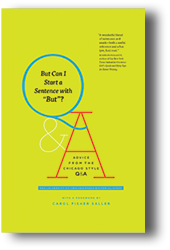
But Can I Start a Sentence with “But”? Advice from the Chicago Style Q&A
The University of Chicago Press Editorial Staff. 2016. Chicago, IL: The University of Chicago Press. [ISBN 978-0-226-37064-4. 118 pages, including index. US$15.00 (softcover).]
Are you a word maniac, a grammar addict, a vivid follower of guidelines presented by the Big Orange? Then But Can I Start a Sentence with “But? Advice from the Chicago Style Q&A is just the book for you. The slim volume is a “Best of” from the archive of the Chicago Manual of Style Q&A (CMOS) Web site. Everything that is contained in the book has been published online, most of it chosen because it shows what makes the conversations on the CMOS Q&A Web site so special: questioners who have unbelievably detailed, serious queries about grammar and style—and CMOS editors whose answers sometimes cannot hide how amazed they are about the seriousness of the question, as style is often a matter of judgment—what is correct in one situation is inappropriate in another.
In the book, questions and answers are grouped into categories such as “Three people have three strong opinions about commas…which includes sections on commas, hyphens, vertical lists, and so on. You can also use the index to look up an entry, but I would not see myself using But Can I Start a Sentence with “But”? as a reference.
Very often questioners are looking for a clear decision based on CMOS rules. And very often, the answer they receive is a reply such as the following: “There’s usually no ‘correct’ winner; it’s a judgment call” (p. 8). Sometimes, questioners are quite desperate and need to be calmed. When a questioner ends their question about hyphenation with the call for help “What’s a diligent hyphenator to do?”, the answer starts with “The hyphenator needs to chill” (p. 36).
Similarly, another answer appeals to the questioner’s common sense, perhaps also showing that patience is wearing thin on the editor’s side (p. 42):
Q. Is there a period after an abbreviation of a country if it is terminating a sentence? “I went to the U.K..”
A. Seriously, have you ever seen two periods in a row like that in print? If we told you to put two periods, would you do it? Would you set your hair on fire if CMOS said you should?
In the Foreward, Q&A Editor Carol Fisher Saller writes, “…over the years, the Q&A has developed a … voice” (p. xi). This voice is unique, respectful, sometimes tongue-in-cheek, and the reason why this book is fun to read.
Karina Lehrner-Mayer
Karina Lehrner-Mayer is a Senior STC member, holds a degree in translation and has over 15 years’ experience in Technical Communication. She works as a Technical Writer at ISIS Papyrus Europe AG, an Austrian-based company offering solutions for inbound and outbound business communications.
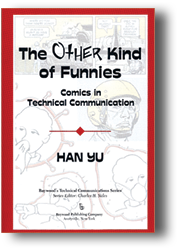
The Other Kind of Funnies: Comics in Technical Communication
Han Yu. 2015. Amityville, NY: Baywood Publishing Company. [ISBN 978-0-89503-840-1. 276 pages, including index. US$85.00 (softcover).]
In 1956, Popular Science magazine introduced a feature that ran monthly until1991 when it switched to The Family Handyman. Roy Doty created and drew “The Wordless Workshop,” presenting a family faced with small, nagging household problems such as storing cleaning supplies, arranging spices, and sorting laundry. As the title suggests, the solutions were presented only through pictures with occasional numbers. While not the first such comic that explained how to build something, it was highly popular and was eventually published in book form (1996). Yu’s The Other Kind of Funnies: Comics in Technical Communication examines in detail such uses for comics when presenting technical subjects.
In nine chapters that fall roughly into three parts, she traces comics’ development past and present. While the U.S. does not use many such formats, other countries do. She examines comics in Japan, Belgium/France, Africa, Asia, and Latin America. The first four chapters establish the history of comics and, then, beginning with Chapter 5, Yu describes specific genres of comics. The third section is an overall conclusion and looking ahead. Students and teachers, the primary audience, should find the first section useful as starters for research and projects. Practitioners might find the middle section interesting.
Each genre chapter follows a pattern: An introduction to the genre, types of the genre, and techniques used in the genre (but not how-to-do comics in that genre). The genres that Yu covers in the second part are instructional comics (Chapter 5), developmental comics (6), educational comics (7), and propaganda comics (8). In instructional comics, she looks at comics for military and civilian use: product manuals, safety guidelines, and training documents among others. Developmental comics include communications related to human development: health, gender inequality, poverty, diversity, and the environment. Educational comics convey teaching, learning, and knowledge dissemination. Propaganda comics attempt to influence the audience’s thinking.
Tec hnical communicators would probably find the book difficult reading because of the scholarly apparatus and be looking for how to use comics effectively. Unfortunately, Yu comes up short on the “how-to-use.” The Other Kind of Funnies would make an excellent book for a seminar in genres because of its coverage and the opportunities for further research. Yu uses many earlier comics, both on their own and in applications such as technical communication, but a large percentage of her references are quite old, some from the ١٩٥٠s.
The idea of using comics in technical communication is an interesting approach—as are all such that increase the transfer of information from those who have it to those who need it. Like all innovations not fully formed, it needs more research, especially current research. Therefore, students and faculty should find plenty in this book to start them toward doing such research.
Tom Warren
Tom Warren is an STC Fellow, Jay R. Gould Award for Excellence recipient, and professor emeritus of English (technical writing) at Oklahoma State University, where he established the BA, MA, and PhD technical writing programs. Past president of INTECOM, he served as guest professor at the University of Paderborn, Germany.
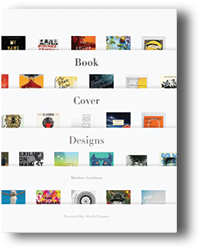
Book Cover Designs
Matthew Goodman. 2016. Atglen, PA: Schiffer Publishing, Ltd. [ISBN 978-0-7643-5016-0. 224 pages. US$34.99 (softcover).]
Every successful book cover design begins with serious research. The graphic artist must first be familiar with the latest trends in the book publishing industry, the preferences of the individual publishing house, and the book’s genre. This information can help the designer hone in on appropriate cover designs. But the content of the book and the author’s unique perspective, as interpreted by the designer, is what will give birth to a memorable cover.
Goodman has featured over fifty book cover designers in his oversized (8.5 by 11 inch) paperback printed on glossy paper. He allots several pages to each contributing graphic artist, starting with a photo, brief biography, and credentials. This first section is followed by the designer’s explanation of the approach he or she took to get creative juices flowing and find inspiration; also, what speaks to the artist indicating a final design.
Several pages follow which display actual front covers credited to the designer. These are six to eight book cover images, reduced to half-size and printed in full color. To maintain balance, the book occasionally includes a full-sized image.
The majority of covers showcased are for trade books—novels, mysteries, and classic tales—whose authors like Truman Capote and Patrick Flanery are easily recognized. Trends in these genres lean toward highly graphic designs…swirls and lines, layered artwork, and fonts that become the graphics themselves. A cover today may remind one of superhero fight scenes straight from a comic book.
Stock photos preferred by amateurs—authors or designers—are clearly passé. Even biographies sport a stylized image. It might be the celebrity’s name rotated 90 degrees over his image or a cut-out photograph of a singing group positioned along the side edge and laid over a darker background.
Technical communicators will be pleased at the sampling of covers for non-fiction works including cookbooks, biographies, and reference guides. Titles have moved to UPPERCASE…seldom Title Case. They are often separated from the subtitle by using linear objects, likes forks, as ruling lines. Many of the techniques shown can easily be duplicated in house with Photoshop. Or if your company wishes to hire one of these talented professionals, contact information is included at the end of the book. An index of book titles and authors would have been helpful.
Studying new techniques and applying latest trends to your company white papers and blog posts could do much to improve readership. Simply replacing a tired manual front cover might inspire a corporate-wide branding revamp. And who knows what revenue increases may result by switching to a splashy image that attracts a younger generation of customers.
Donna Ford
Donna Ford has been an STC member, joining in 1990 and serving on her local chapter’s board for many years. She has been a technical writer since 1987 in the hardware, software, and government healthcare industries. Donna holds a certificate in Information Design from Bentley College. She also reviews books online for the US Review of Books.
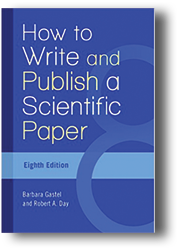
How to Write and Publish a Scientific Paper
Barbara Gastel and Robert A. Day. 2016. 8th ed. Santa Barbara, CA: Greenwood. [ISBN 978-1-4408-4262-7. 327 pages, including index. US$61.00.]
Any book that reaches an 8th edition and is not a textbook must be doing something right. Since 1979, How to Write and Publish a Scientific Paper has helped authors publish scientific papers. Originally targeted to graduate students in microbiology, subsequent editions broadened the scope to biology and chemistry, but students in the social sciences and computer sciences also benefit.
Part I presents in six chapters a scientific writing overview. Beginning with Part II and chapter 7, Gastel and Day presents how authors should produce the scientific paper. They present in individual chapters different parts such as the title (chapter 7), author’s list (8), abstract (9), and so forth through citing references (15). Part III discusses tables, graphs, and photographs. The fourth part addresses the second part of the title, how to publish the paper and what happens at the journal when you send your paper for consideration. Both authors are or have been journal editors.
Part V presents other forms associated with publication such as the review paper and writing for the public. Conference papers and posters are important and receive a separate part (VI). Part VII addresses style based on traditional grammar. Finally, Part VIII addresses additional forms such as grant proposals and writing peer reviews. The book concludes with four appendixes, a glossary, references the authors use, and the index.
One surprising element—and I wonder how many other reviewers mentioned this and why the authors did not follow up on it (see, for example, Technical Communication, vol. 54, number 2, p. 248)—is the claim that the book’s popularity is also due to the jokes and the cartoons. Because the authors target not only native speakers of American English, but also international English for second language speakers, you have to wonder why these jokes are in the book. For example, in a discussion of jargon, we find this sentence: “The jargonist really gets his jollies…” (p. 211). What is a second language speaker to make of this? Another example that has been in all editions since the first is a list labeled “The Ten Commandments of Good Writing” (p. 197) and then lists 10 examples of what not to do. The authors do not explain that these examples are ironic. If the authors are working on a 9th edition and will not delete these dubious jokes, then they should be set off to the side perhaps boxed and shaded and certainly explained.
What about technical communicators? Two matters make the book valuable. First, if colleagues ask for help in writing their scientific papers, technical communicators can point to this book as giving good advice, but with a strong caution about the jokes. The second is to enhance the technical communicator’s knowledge of what is scientific writing. In sum, How to Write and Publish a Scientific Paper has merit for technical communicators and should at least be found in a company or reference library.
Tom Warren
Tom Warren is an STC Fellow, Jay R. Gould Award for Excellence recipient, and professor emeritus of English (technical writing) at Oklahoma State University, where he established the BA, MA, and PhD technical writing programs. Past president of INTECOM, he served as guest professor at the University of Paderborn, Germany.
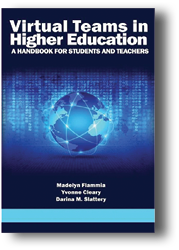
Virtual Teams in Higher Education: A Handbook for Students and Teachers
Madelyn Flammia, Yvonne Cleary, and Darina M. Slattery. 2016. Charlotte, NC: Information Age Publishing, Inc. [ISBN 978-1-6812-3262-1. 212 pages, including index. US$45.99 (softcover).]
Teaching technical writing focuses on what communication skills students will need in the workplace. When business, industry, and government take advantage of new technology, technical communication academics need to prepare the students for such situations. Flammia et al.’s Visual Teams in Higher Education: A Handbook for Students and Teachers provides some answers as well as resources to help both students and teachers develop and participate in such teams.
Flammia et al. offer guidance to students participating in virtual team projects because multinational corporations, small businesses, and nonprofit organizations use virtual structures with increasing frequency. These virtual teams are “workgroups composed of members who rely on computer-mediated communication to accomplish their goals” (p. 4).
The authors divide their book into three major parts: Part I sets the context for virtual teams and introduces the topic; Part II lists the challenges facing students and teachers in establishing virtual teams; and Part III offers guidelines. Two appendixes provide a case study and a listing of different resources.
Flammia et al. identify four groups of challenges that virtual teams will face: communication (discussed in Chapter 3), technological (4), management (5), and cultural (6). Each chapter provides extensive discussions of the literature available from both nonacademic and academic research. The authors argue that because there is little research on academic virtual teams, they review nonacademic virtual team literature and apply it to academic situations.
The overall challenge faced by students and teachers is the radical shift from face-to-face classroom experiences to virtual experiences involving students from different schools. In this particular case, the schools are located in the United States, Ireland, and France. The case study presents the results of the virtual team exercise in which students in the United States and Ireland produce a simple set of instructions and then French students translate and localize them. Topics selected were setting up a Facebook account or email account, among others. The major academic advantage of virtual teams is working with others at diverse locations.
The emphasis on the research available for both nonacademic and academic virtual teams means that Visual Teams in Higher Education works well as an introduction or overview for setting up, running, and ending academic virtual teams. However, when you look into Parts II and III, which are the heart of the approach, you find few how-to-do-it suggestions. For example, in chapter 5 on management challenges, we read that team leaders are responsible for establishing a positive learning environment, but find nothing to suggest how that is done. Even the case study in Appendix 1 offers little in the way of nuts-and-bolts activities. I would also urge that the authors look at Project Management Institute materials.
As an introduction to academic virtual teams as well as providing necessary background, Visual Teams in Higher Education succeeds, but the subtitle is misleading because both students and faculty need additional information.
Tom Warren
Tom Warren is an STC Fellow, Jay R. Gould Award for Excellence recipient, and professor emeritus of English (technical writing) at Oklahoma State University, where he established the BA, MA, and PhD technical writing programs. Past president of INTECOM, he served as guest professor at the University of Paderborn, Germany.

